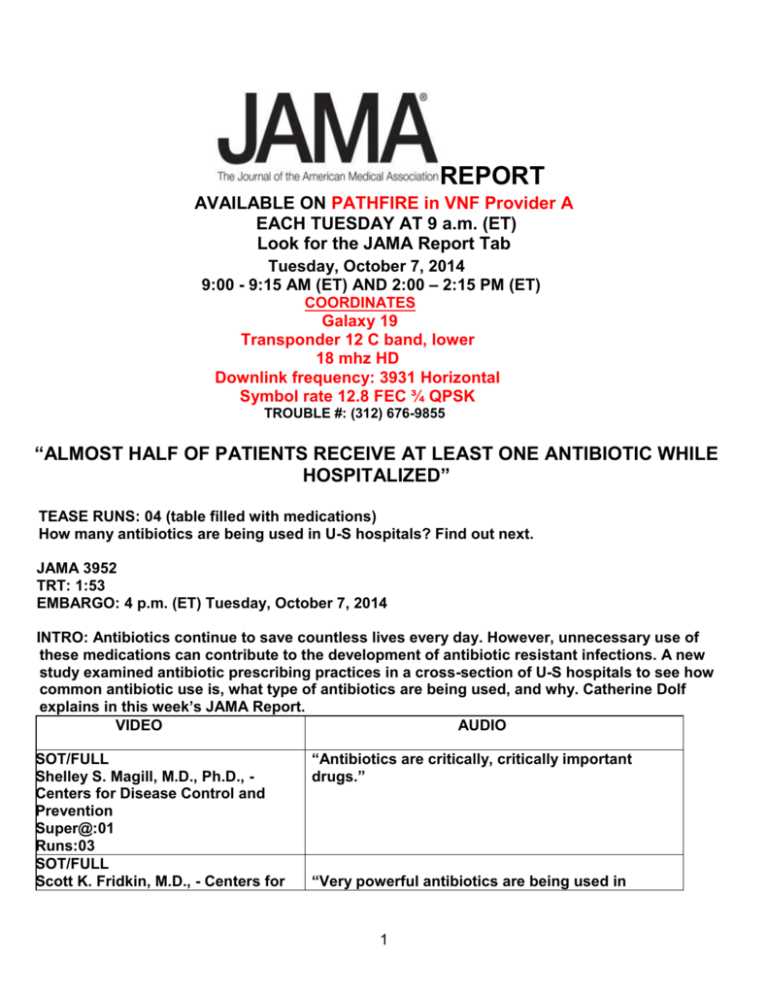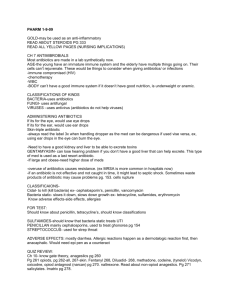Almost Half Of Patients Receive At Least One Antibiotic While
advertisement

REPORT AVAILABLE ON PATHFIRE in VNF Provider A EACH TUESDAY AT 9 a.m. (ET) Look for the JAMA Report Tab Tuesday, October 7, 2014 9:00 - 9:15 AM (ET) AND 2:00 – 2:15 PM (ET) COORDINATES Galaxy 19 Transponder 12 C band, lower 18 mhz HD Downlink frequency: 3931 Horizontal Symbol rate 12.8 FEC ¾ QPSK TROUBLE #: (312) 676-9855 “ALMOST HALF OF PATIENTS RECEIVE AT LEAST ONE ANTIBIOTIC WHILE HOSPITALIZED” TEASE RUNS: 04 (table filled with medications) How many antibiotics are being used in U-S hospitals? Find out next. JAMA 3952 TRT: 1:53 EMBARGO: 4 p.m. (ET) Tuesday, October 7, 2014 INTRO: Antibiotics continue to save countless lives every day. However, unnecessary use of these medications can contribute to the development of antibiotic resistant infections. A new study examined antibiotic prescribing practices in a cross-section of U-S hospitals to see how common antibiotic use is, what type of antibiotics are being used, and why. Catherine Dolf explains in this week’s JAMA Report. VIDEO AUDIO SOT/FULL Shelley S. Magill, M.D., Ph.D., Centers for Disease Control and Prevention Super@:01 Runs:03 SOT/FULL Scott K. Fridkin, M.D., - Centers for “Antibiotics are critically, critically important drugs.” “Very powerful antibiotics are being used in 1 Disease Control and Prevention Super@:04 Runs:16 (Video covering end of bite: stacks of medication, slides being looked at under microscope) B-ROLL Dr. Magill and Dr. Fridkin walking down hallway, sitting at table looking at study, various shots of staff working in hospital situations you wouldn’t normally expect them to be used, which suggests there’s probably room for improvement to eliminate unnecessary antibiotic use. Unnecessary antibiotic use is one of the key drivers for the development of antibiotic resistant infections.” DOCTORS SHELLEY MAGILL AND SCOTT FRIDKIN FROM THE CENTERS FOR DISEASE CONTROL AND PREVENTION AND CO-AUTHORS CONDUCTED A CROSS-SECTIONAL SURVEY OF 183 U-S HOSPITALS. FROM MAY THRU SEPTEMBER OF 2011, EACH HOSPITAL SELECTED A SPECIFIC DAY TO REPORT ON WHAT TYPE OF ANTIBIOTICS HOSPITALIZED PATIENTS WERE RECEIVING. SOT/FULL Shelley S. Magill, M.D., Ph.D., Centers for Disease Control and Prevention Super@:41 Runs:08 (Video covering 1st part of bite: patient in hospital bed) GXF FULL JAMA COVER “One out of every two patients that were surveyed was on an antibiotic. About half of all the patients on antibiotics were getting two or more antibiotics.” SOT/FULL Shelley S. Magill, M.D., Ph.D., Centers for Disease Control and Prevention Super@ :48 Runs:11 (Video covering middle of bite: woman in pharmacy filling prescriptions) B-ROLL Antibiotics in refrigerators, doctor in room with patient, surgery, lab worker “The very most common drug overall was a drug called vancomycin. When we looked at the most common antibiotics that patients were getting we did find that they tended to be what we call broad spectrum antibiotic drugs. SOT/FULL “The line has really been blurred between THE STUDY APPEARS IN JAMA, JOURNAL OF THE AMERICAN MEDICAL ASSOCIATION. BROAD SPECTRUM ANTIBIOTICS, WHICH ARE USED TO TREAT MORE RESISTANT INFECTIONS, WERE NOT ONLY GIVEN TO PATIENTS IN THE INTENSIVE CARE UNIT BUT PRESCRIBED COMMONLY IN REGULAR MEDICAL AND SURGICAL UNITS AND ALSO FOR INFECTIONS THAT BEGAN OUTSIDE THE HOSPITAL, IN THE COMMUNITY. 2 Super @1:13 Runs:10 Scott K. Fridkin, M.D., - Centers for Disease Control and Prevention SOT/FULL Shelley S. Magill, M.D., Ph.D., Centers for Disease Control and Prevention Super@ 1:22 Runs:07 B-ROLL Exterior of the CDC, Dr. Fridkin and Magill talking with staff person reserving these powerful antibiotics for patients that have health care acquired infections and those that have community based infections.” “That might be an opportunity to look more carefully to see if there are ways in which use could be improved in those specific settings.” TO HELP ACCOMPLISH THIS, LAST MARCH THE C-D-C ASKED EVERY U-S HOSPITAL TO IMPLEMENT AN ANTIBIOTIC STEWARDSHIP PROGRAM. SOT/FULL “Having a stewardship program that’s got Scott K. Fridkin, M.D., - Centers for leadership, accountability, drug expertise Disease Control and Prevention monitoring and tracking, that’s a program that can Super@1:44 make a difference for all the providers that Runs:14 prescribe antibiotics in hospitals in the US.” (Video covering 1st part of bite: doctor on computer, looking through patient information, people working in pharmacy) B-ROLL CATHERINE DOLF, THE JAMA REPORT. Dr. Fridkin on camera TAG: STUDY AUTHORS SAY THIS SURVEY PROVIDES A FOUNDATION TO HOSPITALS FOR ASSESSING OPPORTUNITIES TO IMPROVE ANTIBIOTIC USE. Please see the complete study for additional information, including other authors, author contributions and affiliations, financial disclosures, funding and support, etc. TO CONTACT: Dr. Shelley Magill and Dr. Scott Fridkin call: Melissa Brower at (404) 639-4718 doi.10.1001/jama.2014.12923 ADDITIONAL SOUNDBITES: Shelley S. Magill, M.D., Ph.D., - Centers for Disease Control and Prevention QUOTE 1 Runs :15 “This information allows providers in hospitals to look overall at antibiotic use and see where antibiotics are being used most commonly in the hospital, for what reason and those could be areas to target for improving antibiotic use.” 3 Scott K. Fridkin, M.D., - Centers for Disease Control and Prevention QUOTE 1 Runs:14 “Antibiotics are a precious resource, they’re lifesaving drugs. However, we’re at risk for losing their effectiveness and at risk for losing them for our generation and future generations if we don’t act now to preserve their effectiveness.” 4




